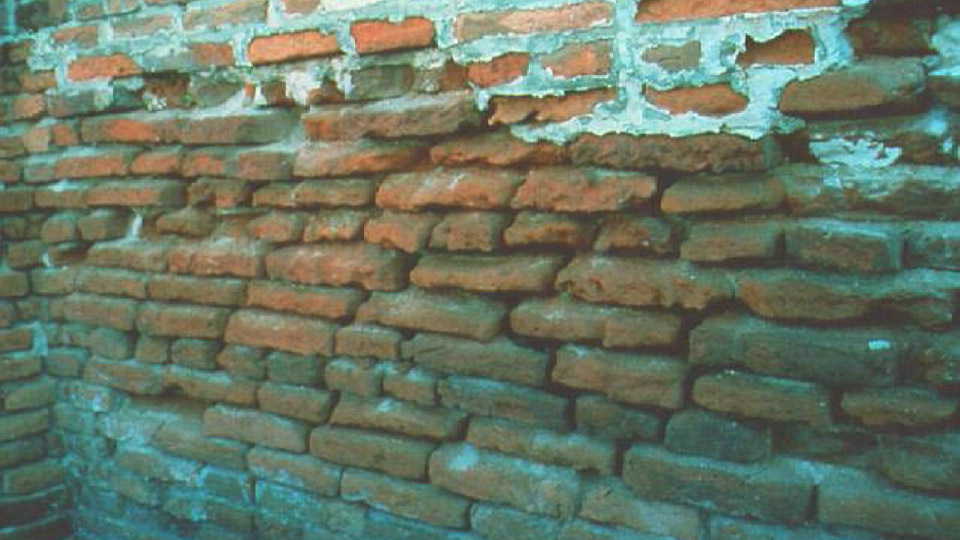Mortar and Grout: Historic Mortar Repair

Damage to masonry units due to repointing with an incompatible mortar.
With new construction, mortar is chosen to offer the best combination of strength, durability, aesthetics, and water penetration resistance. But if you are working on a historic building, you may notice something different with the mortar specifications – little or no Portland cement, requirements for natural hydraulic lime, or strange sand gradations. Mortar used for repointing or rebuilding historic masonry is specified based primarily on compatibility and appearance concepts, with strength being a secondary consideration.
It is important to specify the proper mortar mix for repointing an old or historic building since using an incompatible mortar can lead to damage and costly future repairs. Using a compatible mortar for repointing is essential because properties such as strength, stiffness and water vapor transmission should be similar to the existing mortar and masonry units. In the case of repairs to historic buildings, stronger mortar is not necessarily better. When a stronger, harder mortar is used to repoint over a softer, weaker mortar, this can lead to several undesirable effects. The original soft mortar can accommodate small movements better since it is softer and more forgiving. Repointing with a harder mortar concentrates stresses at the face of the wall which causes spalling and cracking in masonry units and delamination at the mortar/unit interface. In addition, a harder mortar does not allow moisture to move through the mortar joints as easily, forcing water vapor to pass through the masonry units and accelerating their deterioration. It is better to think of mortar as being a sacrificial element within the wall – it is a lot easier to repoint mortar than it is to replace masonry units, and using a harder mortar can lead to the unnecessary and costly replacement of units.
Mortar in historic masonry typically consists of the following components.
- Aggregate – sand, crushed rock, crushed shells
- Binder – non- hydraulic (clay, hydrated lime, brick dust), or hydraulic (gypsum, hydraulic lime, cements, pozzolans)
- Additives – pigment, animal hair, brick dust
If you need to match the sand used in your historic mortar, look near the project site. Aggregate tended to come from readily available materials in the area since it was heavy and expensive to transport. The binder bonds the aggregate together and can be non-hydraulic, meaning it does not require water for gaining strength, or hydraulic in which case water is needed to harden and set. Finally, additives can change the mortar appearance, such as color, or properties, such as strength or hardening time.
Historic mortars typically consisted of 1 part binder and 1 to 4 parts sand aggregate. Prior to availability of Portland cement, most mortars were relatively soft, consisting of simple sand-lime mixes. Harder cement-based mortars started being used between about 1890 and 1920, depending on location. For comparison, Type S mortar, which is a hard mortar commonly used for new construction, contains of 3 parts binder (2 parts Portland cement and 1 part lime) and 6 ¾ to 9 parts aggregate.
Many historic projects require some laboratory testing to identify original mortar components and determine a suitable repair mortar formulation to match the strength and appearance of original mortar. This analysis can include petrography and chemical testing. Petrographic examination using a microscope is useful for identifying specific mortar materials, admixtures, mortar air content, and the causes of any deterioration. Chemical analysis determines the ratio of binder to aggregate and the sand gradation. ASTM C1713, Standard Specification for Mortars for the Repair of Historic Masonry, provides guidance on determining whether repair mortars are compatible.
So what do you do when you have to repoint an old building and there are no resources to analyze the existing mortar? For most cases one option would be to go with a Type O mortar consisting of 3 parts binder (comprised of 1 part Portland cement and 2 parts lime) and 8 to 9 parts sand. It is better to err on the softer side since it is easier to repair deteriorated mortar joints than failed units. If you have hard brick, stone, or require better durability, Type N mortar (1 part portland cement, 1 part lime, and 4 ½ to 6 parts sand) is a reasonable choice.